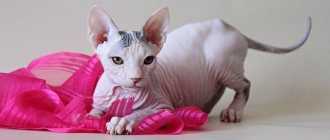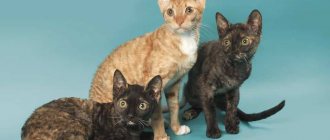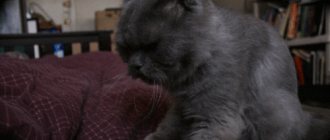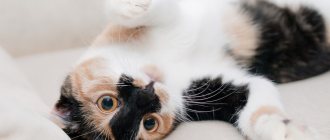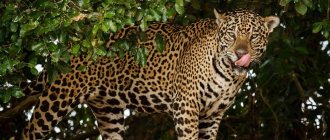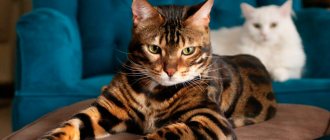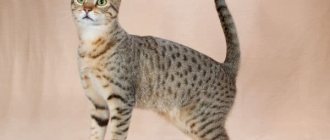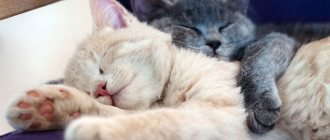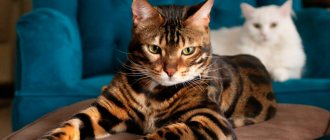When planning to have a cat in your home, it is worth studying in advance the characteristics of different breeds. Not every pet becomes an affectionate friend, and some felines can even attack their owner. In the ranking of the most dangerous breeds, the Savannah takes the lead. Her quarrelsome and aggressive disposition will cause a lot of trouble for an inexperienced owner.
Not all cats, even domestic ones, can be affectionate with humans and other animals. A small kitten that has just been brought home may immediately begin to show a wild disposition.
The most dangerous cats in the world are the lynx, tigress, and panther. And these are large representatives of cat breeds that live in nature.
But it's not that simple. It turns out that there are the most dangerous breeds of cats that people can keep at home. However, they can cause terrible injuries to humans. The names of the breeds of such cats included in the top cause surprise, and sometimes even disbelief of the reliability of the information.
Often in photographs with a charming kitten playing you can see a happy family. Who knows, perhaps this future cat in the photo will turn out to be a dangerous predator. Therefore, before taking an animal into your home, you need to know everything about the pet’s character and habits, and be prepared for unexpected surprises.
Maine Coon
Of the domestic cats, the largest is the Maine Coon, which has a massive body and a wide chest. A non-obese Maine Coon can weigh up to 15 kg. They are often bred as exotic cats. But they may not be harmless, sometimes they can show aggression, and the large size of the cat can mean more serious injuries. If a stranger enters the territory of the house, the Maine Coon may meet him aggressively. But at the same time, breeders note their flexibility and high intelligence - Maine Coons can pick up on the intonations of their owners and respond to their requests. They are very curious and therefore require close attention to themselves. They don’t like to be left alone, so if a Maine Coon needs to be left alone for a while, then you should provide it with toys, otherwise the owners will later regret leaving it. Maine Coons do not require special conditions to keep; they feel good in any climate. But during walks you should not leave them alone, as their mood can instantly change.
Early communication
It refers to communication between a kitten and a person. But you need to clearly understand that until the baby is 8 weeks old, you cannot separate him from his mother. Eight weeks is the minimum period to begin socialization. At this time, the cat is already ready to learn play and hunting skills, he can learn good behavior during grooming, and is ready to learn the norms of behavior in the cat community. Finally, 8 weeks is when the kitten is ready to feel confident. Those babies who were separated from their mother too early have excessive aggression. It is very difficult to make such a cat affectionate.
Kittens separated from their mother early are aggressive, fearful, distrustful, and also emotionally unstable. Aggression is the most difficult case, since such a cat has little chance of becoming kind and docile. But early separation from your mother cat can be compensated for!
Let's consider what the owner needs to do.
- When you adopt a kitten, create an environment around it that will not change every day. They say that a dog gets used to its owner, and a cat gets used to the house. There really is a lot of truth in this. If everything changes in his room (more precisely, in the one where he is most often), if you constantly offer him new beds and toys, he will be confused. Then confusion will be replaced by wariness, and then aggression is not far away.
- You can teach a cat to be affectionate and agreeable only if the person himself is calm, predictable for the cat, and stable. Whatever one may say, without this it is impossible to achieve what you want. You need your pet to stop being afraid of you, to respond well to your voice, to know your habits, etc.
Ocicat
The breed received official registration in 1987 and is a derivative of a mixture of Siamese, Abyssinian and American Shorthair blood. The appearance of Ocicats is colorful, reminiscent of wild cats. Personality: sociable, inquisitive, friendly. Read more about Ocicats in our article.
Pets are “talkative” and express the entire range of emotions with their voices. Not receiving enough attention to the person, they begin to sing, meow, influencing the owner in every way, reminding them of themselves. They have a tenacious memory, a remarkable mind, and quickly figure out how to open a refrigerator or closet door. They are easy to teach funny tricks. They are playful, active, aggression is not a characteristic feeling for them.
Small spotted cat
Well, very expressive eyes
Her middle name is Oncilla. Small, very cute and quite rare animals, distinguished by their particular bloodthirstiness.
These spotted predators live in the tropical forests of America. Elegantly built, resembling a miniature leopard with a sullen expression, oncillas love to spend the daytime in idleness. Namely, rest on tree branches, hiding in the shade. Small spotted cats prefer to be nocturnal. When the sun goes below the horizon, oncillas turn into bloodthirsty four-legged furies. Representatives of this species are known for their increased aggressiveness.
Fortunately, animals practically do not see people. Despite their size, and the cats weigh only 2-3 kg, oncillas attack humans without hesitation. These forest dwellers will not be embarrassed at all by the fact that the enemy is much larger and stronger than them.
civet cat
Leopard, no less
The second name of the animal is fisher cat or fish cat. The cats received their first name for their resemblance to the civet or, as it is also called, the civet.
Fishing cats settled in Southeast Asia. China, India, Thailand, Sumatra, Java are their main habitats. Animals prefer to settle near rivers and lakes where fish are found.
Fish cats are quite large creatures. The size of an adult cat can reach 40 cm at the withers and weigh 15 kg; females are almost twice as light.
The peculiarity of animals is their unusual paws. Viverrid cats have membranes between the toes of their front paws. Representatives of the species are excellent swimmers, but they have problems climbing trees: they can, but extremely rarely and reluctantly. And why climb a tree if fish don’t grow there...
The main diet of civet cats is fish caught with their own paws. Moreover, the animals engage in fishing during the day, sitting motionless in shallow water. Noticing a fish swimming past, the cats sharply hit it with their paw and, hooking it with their claws, pull it ashore. By the way, fishermen have problems with retracting their claws, because the membranes prevent this from happening.
Viverrid cats avoid meeting people. But if this happens in the wild, representatives of this species of cat will, without hesitation, go on the attack.
Kalimantan cat
Among the thickets, suddenly a cat appeared
The animal got its name due to the island on which it lives. There are very few Kalimantan cats left; they are listed in the International Red Book.
Representatives of the species are small creatures, weighing up to 3.5-4 kg. But the character of Kalimantan cats is legendary among zoologists studying the species. It is known that the only specimen that was caught in 2011 was sent to a national park in Malaysia, where it demonstrated itself in all its glory. Not only did the predator attack everything that moved, it also caused injuries to park employees. Over time, the animal became somewhat accustomed to the new conditions, but continued to react aggressively to people.
As for Borneo cats - their second name - living in the wild, they are famous for their bad character. Representatives of the species are extremely aggressive, attack with lightning speed, and are capable of attacking an animal several times larger than the predators themselves. In most cases, monkeys, birds and reptiles become lunch for cats from the island of Kalimantan. The meeting of this predator with a person will end in injuring the latter.
Chausie
Chausie cat breed
This is a new breed of cat, bred by crossing a domestic Abyssinian cat with a wild jungle cat, and was registered in 1995. Breeders wanted to get a new breed that would retain the appearance of a wild cat, but have the character of a domestic cat. Externally, the Chausie is similar to a cougar; they have a powerful, slender body, much more powerful than that of most domestic cats. Cats of this breed are ready to hunt around the clock. Families who dare to adopt a Chausie kitten are subject to strict requirements, given the aggressiveness of these animals. People should, from childhood, prevent any attempts to play dangerous games with chausies. Otherwise, this breed can be called very inquisitive and even kind. This breed is characterized by a balanced temperament, developed intelligence and self-esteem. You should not have chausie in small city apartments, as they need a lot of space. They do not strive for privacy; on the contrary, they try to attract the attention of any person. They need regular training, especially since they love heights, which can damage some fragile household items that are best removed in advance.
Savannah
The very graceful Savannah is one of the most aggressive cat breeds. She has a slightly elongated, slender body, a small head with pointed ears, set on a long neck, and soft-to-the-touch, thick, short fur that is leopard-print in color. Although the Savannah is often ready to show wildness and aggression, the owner can teach her to accompany himself on a leash. However, even then you need to be vigilant while walking, since the savannah may well treat a stranger as an object of hunting.
Top 10 most dangerous snakes in the world People cannot be indifferent to snakes - watching them from a safe place causes delight, and close contact often turns into...
Abyssinians
Cats of the vengeful and evil Abyssinian breed sport a dense thick coat of tricolor color. They do not like to sit on their owner’s lap for a long time, preferring a higher place where they would be out of reach. Because of the vindictiveness of Abyssinians, it takes a lot of time to raise them. You need to be prepared for the bites and scratches that usually end up playing with them. Breeders say that Abyssinians easily get along not only with people, but also with other animals, but if they don’t like something, expect aggression. These are very inquisitive and attentive animals, moderately mobile and capable of occupying themselves independently in the absence of their owners. Their games often cause scratches on furniture and ties on the curtains they like to hang on. But it’s better not to scold them for this, otherwise you may encounter aggression. If an Abyssinian wants to rest, he will climb onto his owner’s lap. This breed is quite silent and rarely bothers with its screams. The owner, if desired, can start training his Abyssinian dog: teach her to fetch something or walk on a leash. Developed intelligence and devotion are the strengths of the Abyssinians; they follow their owner everywhere because they do not tolerate loneliness.
Dune cat
King of the Dunes
In the once popular song of O. Gazmanov, the khan urged the tramp not to go to the dune. Motivating the call by the fact that the flowers needed by the tramp do not grow on the dune. In fact, not only do flowers not grow on the dune, there are also cats there that are very aggressive towards people.
It is possible to meet a sand cat, but it is difficult. Its habitat is semi-deserts and rocky deserts with shrubs. Dune cats are found in North Africa, Central and South-West Asia, and the Arabian Peninsula.
Representatives of the species have an unusual appearance. Thanks to its wide head and large ears, from afar it may seem like a fennec fox is in front of a person. But the fox will be larger in size than the cat. In general, the desert inhabitant is considered the smallest among its predatory counterparts. The maximum weight that an adult cat can reach is 3.5 kg, and the height at the withers varies from 25 to 30 cm.
If a person is lucky enough to get into the desert and he sees a cute, dirty red cat with huge eyes, there is no need to run to the animal. The fact is that the sand cat, despite its diminutive size, is extremely aggressive and dangerous to humans.
The desert dweller attacks quickly and sharply. The harbingers of an attack are the ears laid back, pressed to the head, the animal gathers into a ball, makes a loud sound similar to a growl mixed with meowing and jumps forward. A representative of the species, of course, will not kill a person, but it is capable of causing serious injuries.
The main danger of the sand cat is its sharp claws and teeth, which are necessary for survival in the desert. After all, the animal has to hunt monitor lizards, geckos and even snakes. And jerboas, local hares and mice are frequent guests on the dune cat’s dinner table.
Possible causes of aggression
All known cat breeds can be classified as predators, since all living creatures have aggressiveness, only in some it is weakly expressed, and in others it is stronger. Different experts explain aggression in different ways.
If we consider the main reasons why a creature becomes embittered, these include:
- Pain.
- Fear.
- Territorial division.
It is impossible to say unequivocally which breed ranks first in the ranking of the most aggressive ones; we can highlight a list of those whose natural essence does not disappear over the years.
Quite often, furry owners sincerely do not understand why their beloved cat becomes uncontrollable and angry, because they feed it, love it, care for it, pay attention to it, but it bites every time you try to pick it up.
There are many reasons why the tailed pet has such a character. The most common thing is that an adult is taken from the street and is trying to be tamed. In survival conditions, cats become more aggressive, and they stop trusting people. The second common case is when a person forcibly forces a pet into contact and takes it in his arms. Even if the animal is in your arms, this does not mean that at a given moment in time it is not experiencing stress.
It is also impossible to exclude the physiological characteristics of the character of each individual breed. You must either put up with cat aggression or abandon such a pet. Nevertheless, care for the animal must be shown from birth, this is the only way to prevent an unexpected outburst of aggression towards other people.
